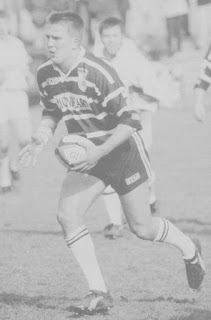Martin Pearson played the first full summer
season with his home town team then left for a successful super league career
and, as so often happens after Featherstone Rovers sell a star player, the club
then simply had to do and make mend. At first, coach David Ward
turned to Neil Summers signed from Bradford. Although lacking pace, he
was a player who showed good skills at Championship level. As a former rugby
union fly-half he also inevitably had a decent kicking game, always a useful
attribute for a stand-off. Unable to claim a place at scrum-half due to veteran
Deryck Fox, former Leeds junior Paddy Handley also played quite a
bit of rugby at number six for Rovers. When David Ward left, he was replaced by
Steve Sims, who was always ready to throw in any youngster who showed promise.
Therefore, Leeds-trained Karl Pratt got an extended run in the halves
towards the end of the 1997 season, before playing the following year on the
wing. Pratt was an exciting talent with pace to burn at Championship level, but
he moved back to Leeds in a big money transfer at the end of the year. What
might have happened had his late try in the Championship final against
Wakefield not been ruled out hardly bears thinking about.
 |
| Andy Bastow |
Handley continued to share the number six role over
the next couple of seasons with first Jamie Coventry, signed from
Castleford juniors and then with ex-Wakefield half-back Ryan Horsley. In
2000, after so much experimentation, new coach Peter Roe decided on a fixed
half-back pairing that played side by side almost unbroken for three full
seasons. At scrum-half was Jamie Rooney, and at stand-off former
Wakefield junior Andy Bastow. Without being the most dynamic of players, Bastow
offered a good foil to Rooney’s creative skills, solid on defence and a good
link to the three-quarters. It was a system that worked well for a generally
overachieving young Rovers team. Whilst he was never a prolific try scorer
himself, Andy offered good distribution to a pacy three-quarter line which at
that time contained some steady try scorers such as Richard Newloveand
a young Danny Kirmond.
At the end of the 2001 season, Roe left for
Wakefield and Rooney followed him there. After 83 games in three seasons,
Bastow was sold to Hunslet and new coach Andy Kelly had to go back to the
drawing board in his search for half-backs. He began with Andy McNally,
an old-style stand-off with acceleration and good distribution. Richard Agar was also used, although he was more of an organiser and tactical kicker. Agar
helped guide his team around the park, a thinking man’s footballer who was
always destined to go into coaching. For an all too brief period, Rovers
enjoyed the talents of Richard Whiting playing for his home town time
before moving to Hull FC after just a few months of first team football at
Featherstone.



